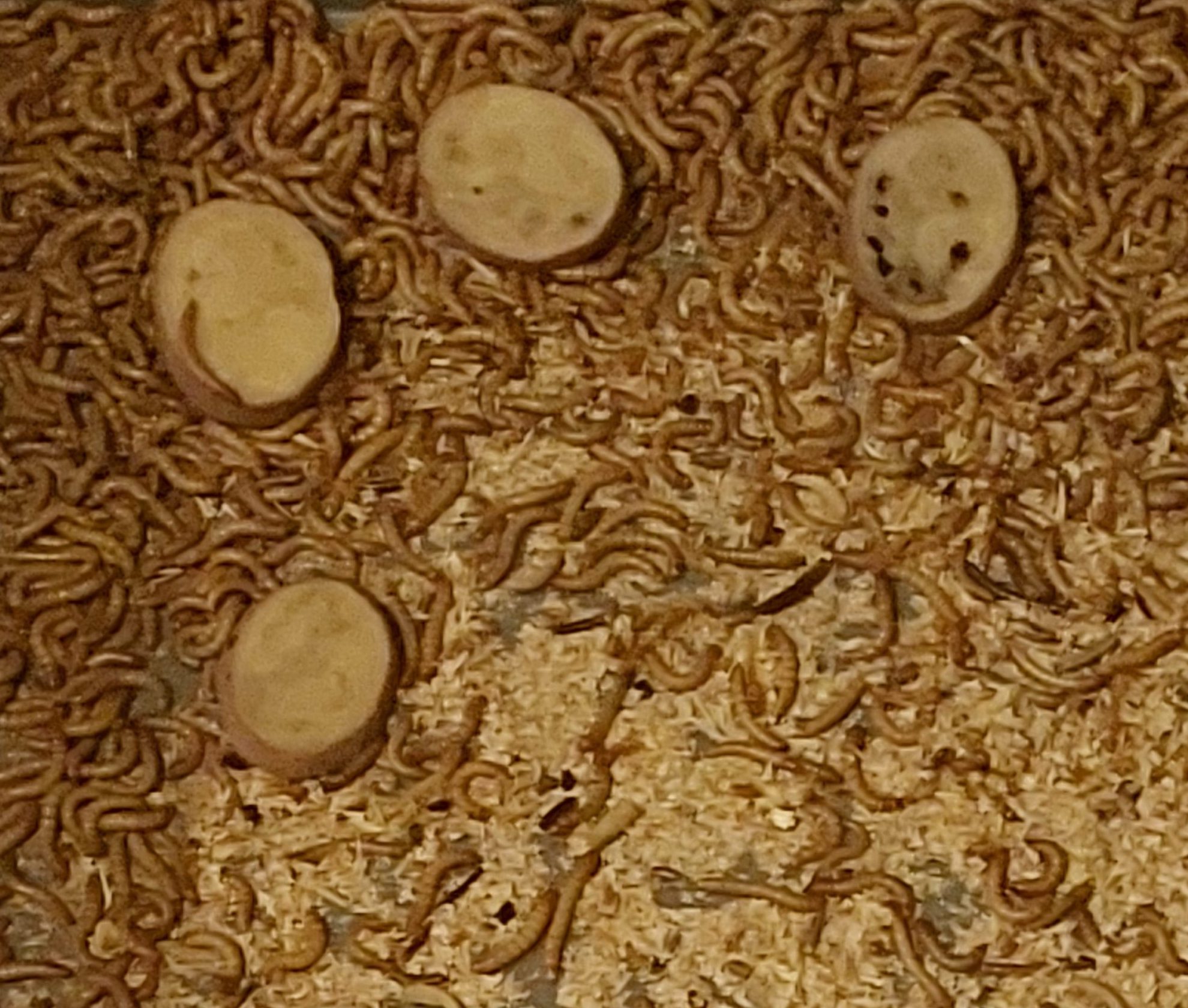Introduction:
Mealworms are a popular choice for sustainable protein production, both as feed for animals and for various eco-friendly projects. To keep your mealworms thriving, a carefully balanced diet is essential. This guide dives into exactly what foods to feed your mealworms, how each impacts their growth, and practical tips for managing their diet effectively.
- Core Diet: Dry Substrate
Mealworms thrive in a bedding that doubles as food, making dry grains and cereals the backbone of their diet.
Wheat Bran: Wheat bran is ideal for mealworms. It provides a light, crumbly base for burrowing and contains carbohydrates and fiber that fuel their growth. Change the bedding monthly to avoid food spoilage and waste buildup.
Rolled Oats or Whole-Grain Oats: A great alternative to wheat bran, oats provide similar nutritional value and structure. Mealworms will feed on the oats as they move through the substrate, which should be kept dry to prevent mold.
Cornmeal and Whole Wheat Flour: Mixed with oats or bran, these ingredients add a softer texture that mealworms enjoy. However, avoid refined or bleached flours as they lack nutrients and can easily compact, making it harder for mealworms to burrow.
Tip: Ensure the substrate remains dry and replace it every 4–6 weeks to maintain a clean environment.
- Hydration from Vegetables: Essential Water Sources
Mealworms don’t drink water directly, so hydrating foods are crucial to keeping them healthy. Vegetables provide moisture and additional nutrients, but they should be carefully selected and monitored.
Carrots: A favorite among mealworms, carrots are moisture-rich, long-lasting, and don’t spoil quickly. Cut them into small, thin slices and place on top of the substrate. Remove any pieces showing mold.
Potatoes: A classic choice, potatoes add both hydration and calories. Quartered potatoes or potato peels work well but require frequent checking, as they can turn slimy if left too long.
Cucumbers: High in water content, cucumbers provide quick hydration but spoil faster than carrots or potatoes. Thin slices are best to prevent mold, and these should be replaced every couple of days.
Pumpkin or Squash: Mealworms enjoy soft vegetables like squash, which provides water and is high in beta carotene. Use small cubes or thin strips and check them daily for spoilage.
Tip: Place veggies on a small piece of cardboard above the substrate for easy removal, and avoid overloading the bin with moisture-heavy foods to prevent mold.
- Protein Boosts: For Faster Growth and Healthier Mealworms
Mealworms, like other livestock, benefit from a protein-rich diet to grow faster and develop better exoskeletons.
Poultry Feed (Non-Medicated): A highly efficient protein source, poultry feed can be used sparingly to boost protein levels. Sprinkle a small amount over the substrate every two weeks.
Dog or Fish Food Pellets (Crushed): Non-spicy, unsalted dog or fish pellets provide protein, fats, and minerals. Pulverize the pellets and mix them into the substrate to ensure even distribution.
Tip: Only introduce protein supplements every 10–14 days to avoid an overly rich environment, which can lead to rapid breeding and overcrowding.
- Fruits: Limited and Carefully Monitored
Fruit provides vitamins and moisture but must be used sparingly due to its high sugar content, which can create a breeding ground for pests and mold.
Apple and Pears: These mild fruits offer gentle hydration and sweetness. Thinly sliced pieces work best and should be removed after 1–2 days to prevent rot.
Banana Peels: A nutritious option, banana peels are safe but spoil quickly. Use small, fresh sections and replace frequently to avoid a sticky mess.
Tip: Avoid all citrus fruits, as the acidity can harm mealworms and disrupt the pH balance of their environment.
- Foods to Avoid: Essential Safety Guidelines
Spicy or Sugary Foods: Avoid any food with added seasonings, sugar, or salt, as these additives can be harmful to mealworms.
High-Water Vegetables (Tomatoes, Peppers): Vegetables with excessive moisture lead to damp conditions and mold growth. Stick to root vegetables like carrots and potatoes for safe hydration.
Citrus Fruits: Oranges, lemons, and similar fruits contain citric acid, which can harm mealworms.
Processed Foods: Avoid anything highly processed or refined, as it typically lacks nutrients and may contain preservatives or additives.
- Feeding Tips for a Thriving Mealworm Colony
Regularly Rotate Foods: Replace uneaten vegetables and protein sources every two days to prevent odors and mold.
Feed in Small Quantities: It’s better to underfeed than overfeed. Start with small portions and adjust based on how quickly the mealworms consume the food.
Observe Behavior and Adjust Accordingly: Mealworms’ activity levels can indicate their health. If they seem lethargic, adjust the amount of protein or check the moisture levels in the bin.
Conclusion:
Feeding mealworms a balanced diet of dry feed, hydration-rich vegetables, and occasional protein boosts keeps them healthy and productive. Following these guidelines will ensure your mealworms thrive, providing a sustainable and nutrient-rich resource for your projects. Whether you’re raising mealworms for protein, composting, or other eco-friendly purposes, a well-managed diet is the key to a successful colony.

